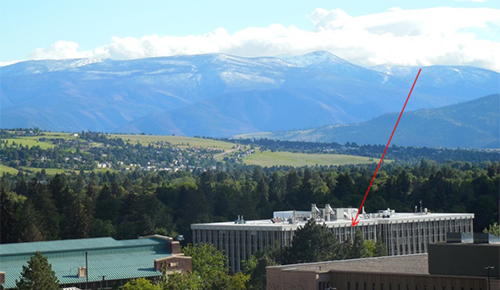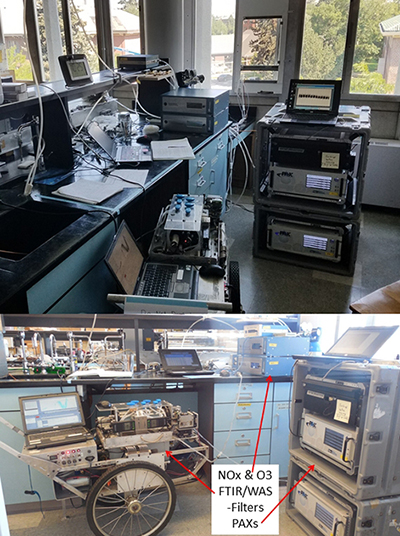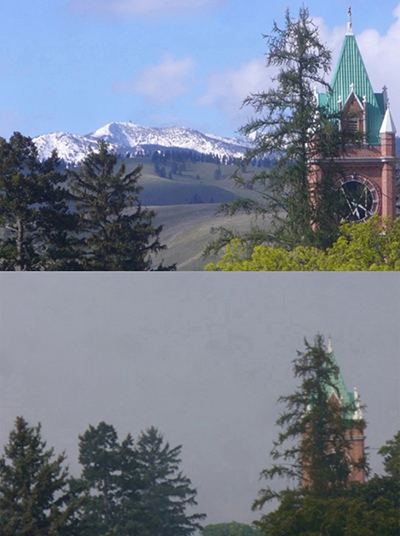Platform: Ground Site

Missoula, MT
Hosted by Robert Yokelson, Department of Chemistry, University of Montana
Instruments and Sampling Location

The University of Montana (UM) deploys instruments at their fourth floor lab on the edge of town summer 2019. (Summer 2017 data is available with Selimovic et al., 2018 and Selimovic et al., 2019. 2018 data is available on request). Major benefits could occur from co-deploying with mobile labs from UNH/Brown/NASA and Aerodyne at times, but all the teams appreciate that the option to "fan out" can increase regional coverage. The power UM set up for Aerodyne (and/or NASA) at the Missoula Fire Lab remains available. The Yokelson lab has space and well over 100 amps of power available for guest deployments. UM places high value on sampling some of the same fires sampled from the air by the FIREX-AQ aircraft and UM is well within sampling range of aircraft based in Boise, ID. UM has a student working on the NASA DC-8 and Yokelson supporting air and ground ops before, during, and after the Boise deployment. UM has the following equipment monitoring smoke (in addition to PM2.5 by BAM-1020):
| Instrument | Measurement Info |
|---|---|
| trace gases, Fourier transform infrared spectroscopy (FTIR) | up to 20 gases including NH3, CO2, CO, CH4, methane, acetic acid, formaldehyde, methanol, ethylene, ethyne, HCN, etc. See Selimovic et al., 2018 for a list of likely analytes |
| NOx, 2B Technologies model 405 nm | UM FTIR NOx may not be sensitive enough if levels are low |
| Ozone, 2B Technologies model 211 | NO gas-phase "scrubber" most resistant to VOC interference |
| Photoacoustic Extinctiometers (PAXs), Droplet Measurement Technologies (DMT) | at 401 and 870 nm for BC, BrC absorption attribution, AAE, SSA |
| Single Particle Soot Photometer Extended Range (SP2-XR), Droplet Measurement Technologies (DMT) | BC mass, coating thickness, size distribution, new product has extended range from 50-800 nm deployed in 2018 - subject to reconfirmation |
| Winds, temperature, RH | from nearest existing station |


Key Research Goals
- Providing quality data to evaluate regional smoke modeling: including, but not limited too inert tracers such as BC and CO, and evolving species such as brown carbon, PM2.5, NOx, and O3.
- Sampling the near-ground wildfire smoke, especially at night and early morning, when it may be inaccessible to aircraft in coordination with the FIREX-AQ campaign in 2019. How does each fixed, mobile, and airborne vantage point contribute to understanding overall impacts?
- How do nighttime vs daytime combustion and nighttime vs daytime post-emission processing impact the empirically-observed chemical make-up of the fresh emissions and slightly-aged smoke, especially regarding observed BrC/CO, etc?
- Hypothetically, at night, enhanced smoldering combustion, NO3 oxidation of NMOG, NH3 chemistry, or other processes might be an important source of BrC emissions that are larger than expected based on daytime sampling. UM measures BrC levels and uses their NO2 and O3 data to estimate nighttime NO3 production. In 2018 we measured high (ppbv/hr) NO3 production rates. More data from 2019 will allow enhanced assessment.
- How do nighttime thunderstorms impact smoke chemistry (via impacts on wet scavenging, O3 transport, and LNOx)?